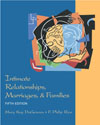 |  Intimate Relationships, Marriages, and Families, 5/e Mary K. DeGenova
Philip F. Rice
Power, Decision Making, and Communication
Chapter ObjectivesAfter reading the chapter, you should be able to:
1.define power and family power. |
 |  |  | 2.outline the different units of family power. |
 |  |  | 3.explain why people want power, pertaining to self-actualization, social expectations, family-of-origin influences, and psychological needs. |
 |  |  | 4.describe the sources of power in families, e.g., cultural norms, gender norms, and economic resources. |
 |  |  | 5.describe the four types of marital power patterns: egalitarian, husband-dominant, wife-dominant, and anarchical. |
 |  |  | 6.describe power tactics-that is, those ways that power is applied. |
 |  |  | 7.discuss the consequences of power struggles on individuals and on marital satisfaction, and explain why equity is needed. |
 |  |  | 8.define communication, both verbal and nonverbal, and tell why it is important in marriage. |
 |  |  | 9.identify the major barriers to communication: physical and environmental, situational, gender, and psychological. |
 |  |  | 10.describe the requirements for improving communication skills: motivation, concern, self-disclosure, clarity, feedback and reciprocity, and arguing constructively. |
|



 2002 McGraw-Hill Higher Education
2002 McGraw-Hill Higher Education